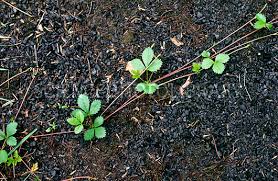Overview
Not all flowering plants reproduce from seeds. Some plants reproduce by making exact copies of themselves, as plantlets, from stems, or from multiple roots. Many plants that have desirable traits can be propagated from cuttings or grafting rather than growing them from seed. Major crops are also domesticated.
Vegetative Reproduction by Plantlets
Plants that do not reproduce from seeds make exact copies of themselves. For example, the spider plant is a familiar houseplant that grows as an herb in tropical regions of Africa and also in Australia. It grows by producing plantlets on the end of its leaves. When those plantlets reach soil, they can root and grow into new plants that are identical to the parent plant.
Vegetative Reproduction by Stolon
A stolon is a long stem that grows at the surface of the soil or just underneath the ground. For example, strawberry plants can reproduce from long stems called runners, because new roots can develop into new plants farther away from the original plant. Some species of bamboo produce a long underground branching root system that sends up entire plants through the soil. Bamboo grows rapidly, because new stalks are at their full diameter as soon as they break through to the surface of the soil.
Plant Propagation
In order to produce many exact copies of parent plants, new plants are not always grown from seeds. Many can develop from cuttings of parts of stems and leaves. Some plants root easily this way. Seedless varieties of plants, such as seedless grapes and oranges, can be propagated by grafting a piece of stem or bud onto another more established tree. The new plant can then grow independently from the mother plant.
Domesticated Crops
The earliest hunter-gatherers did not domesticate crops. They traveled widely to find food sources and gathered wild plants as they roamed. About 10,000 to 11, 500 BCE, groups of people in different parts of the world began to grow wild species of lentils, barley, and wheat and cultivate domesticated varieties. People began to stay in one place, gather in communities, and grow crops for food. Most of the world depends upon staple crops, such as rice, wheat, and corn, but many other types of plants are also cultivated for food.
Interested in science tutoring services? Learn more about how we are assisting thousands of students each academic year.
SchoolTutoring Academy is the premier educational services company for K-12 and college students. We offer tutoring programs for students in K-12, AP classes, and college. To learn more about how we help parents and students in Joplin, MO visit: Tutoring in Joplin, MO




